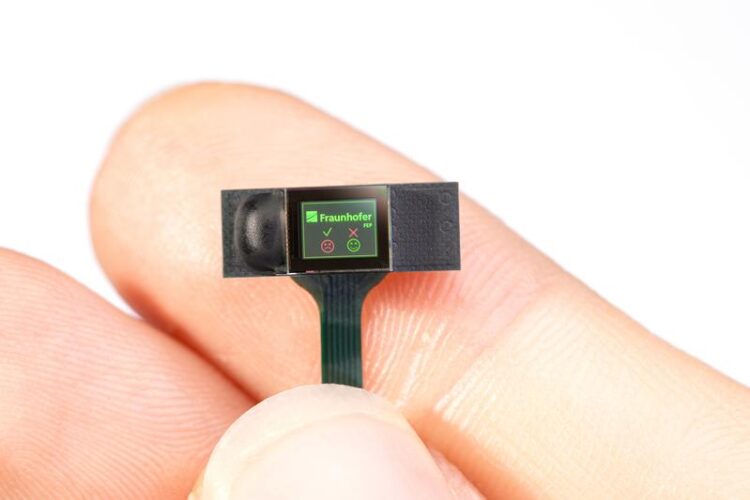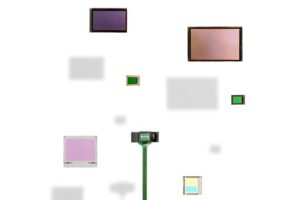Addition to the Microdisplay Family

New ultra-bright and ultra-low-power microdisplay
Claudia Jacquemin / © Fraunhofer FEP; Picture in printable resolution: www.fep.fraunhofer.de/press
New High-Brightness Versions Launched.
In addition to an energy-saving design, microdisplays for wearables must also display information in a way that they are sufficiently bright under daylight conditions, at best in colored versions and recognizable with the naked eye. The OLED microdisplay family of the Fraunhofer Institute for Organic Electronics, Electron Beam and Plasma Technology FEP has now been extended: Microdisplays in a new design for ultra-high brightness. The new versions will be presented for the first time at the SID Display Week, May 10 – 12, 2022, in San José, USA, booth 1320 (German Pavilion).

Claudia Jacquemin / © Fraunhofer FEP; Picture in printable resolution: www.fep.fraunhofer.de/press
Small, ultra-low power and high-contrast OLED microdisplays are predestined for the integration into head-up systems or wearables. They can be used as an assistance system in industry, in logistics to display the warehouse information in employees’ caps or helmets, or for navigation in environments with restricted visibility, e. g. in disaster management. In such augmented reality (AR) scenarios, in addition to a power-saving design of the system, a display with significant brightness is required.
The Researchers at Fraunhofer FEP have extended their OLED microdisplay portfolio in this regard. This ranges from full-color video displays with 1-inch screen size to 0.2-inch small ultra-low power microdisplays. Specifically, the 720p display has been boosted to high brightness levels required for the use in AR applications and optical systems under daylight conditions. The 720p full-color microdisplay (RGBW) is now reaching a brightness level of up to 1,000 nits, while the dual-color version (RGRG) reaches 5,000 nits.
A Nit indicates how much light is emitted in a square meter of surface. For example, TVs have a brightness of 200 – 500 nits. If the OLED microdisplays are used for simple display applications, the 720p version in warm white can even reach up to 35,000 nits.
Bernd Richter, Head of Organic Microelectronic Devices at Fraunhofer FEP, explains how this was accomplished: “Technologically, this increase in brightness was achieved by developing new OLED stacks. By using different filter technologies, we enable a good compromise between brightness and display content, depending on the application.”
In addition, the institute pushed the further development of ultra-low power variants. Along with the above-mentioned displays, new variants are now offered, which make the use in wearables even more attractive due to their longer battery runtime and at the same time higher brightness. These displays are available in monochrome, dual-color or warm-white with new brightness levels from 5.000 to 35.000 nits. The new OLED microdisplays can now display navigation instructions much more brightly in systems such as helmets for outdoor athletes or for firefighting missions, and still manage without charging breaks.
Interested partners now have access to additional display properties for their applications. The scientists at Fraunhofer FEP look forward to the development of customer and application-specific microdisplays.
Philipp Wartenberg, Head of IC and System Design, explains: “With this extension of the portfolio, Fraunhofer FEP offers a unique selection of microdisplays for a wide range of optical and system integrations. The displays differ not only in size, but also in circuit topologies. If there is no suitable microdisplay in our portfolio or if the costumer has special requirements for the control, we will develop these customized for him or her.”
The Fraunhofer FEP offers the development and transfer of microdisplays from a single source: Starting with the development of CMOS circuits, via OLED integration to package and system integration. For initial tests of the technology, evaluation kits are available for all variants.
Fraunhofer FEP at SID Display Week 2022
Exhibition
May 10–12, 2022
Booth no. 1320, German Pavilion
https://sid.german-pavilion.com/en/home
Symposium
New Ultra Low-Power High Brightness Microdisplays Enabling Broad Applications,
Philipp Wartenberg, Fraunhofer FEP
Session 56: System Architectures for VR/AR/MR (Paper Nr. 56.3)
San Jose McEnery Convention Center, Room 220B
Thursday, May 12, 2022, 03:50 – 04:10 pm
http://www.scomminc.com/pcm/sid/sessionList.cfm?selSession=87
Exhibitor Forum
New ultra low-power high brightness microdisplays enabling broad applications
Bernd Richter, Fraunhofer FEP
Tuesday, May 10, 2022, 11:00 – 11:15 am
11:00 – 11:15 Uhr
Center Stage – Exhibit Hall
Session F1: Display Design and Manufacturing
https://www.displayweek.org/2022/Program/Exhibitors-Forum
Press contact:
Mrs. Annett Arnold
Fraunhofer Institute for Organic Electronics, Electron Beam and Plasma Technology FEP
Phone +49 351 2586 333 | presse@fep.fraunhofer.de
Winterbergstraße 28 | 01277 Dresden | Germany | www.fep.fraunhofer.de
Weitere Informationen:
Media Contact
All latest news from the category: Power and Electrical Engineering
This topic covers issues related to energy generation, conversion, transportation and consumption and how the industry is addressing the challenge of energy efficiency in general.
innovations-report provides in-depth and informative reports and articles on subjects ranging from wind energy, fuel cell technology, solar energy, geothermal energy, petroleum, gas, nuclear engineering, alternative energy and energy efficiency to fusion, hydrogen and superconductor technologies.
Newest articles

Trotting robots reveal emergence of animal gait transitions
A four-legged robot trained with machine learning by EPFL researchers has learned to avoid falls by spontaneously switching between walking, trotting, and pronking – a milestone for roboticists as well…

Innovation promises to prevent power pole-top fires
Engineers in Australia have found a new way to make power-pole insulators resistant to fire and electrical sparking, promising to prevent dangerous pole-top fires and reduce blackouts. Pole-top fires pose…

Possible alternative to antibiotics produced by bacteria
Antibacterial substance from staphylococci discovered with new mechanism of action against natural competitors. Many bacteria produce substances to gain an advantage over competitors in their highly competitive natural environment. Researchers…





















